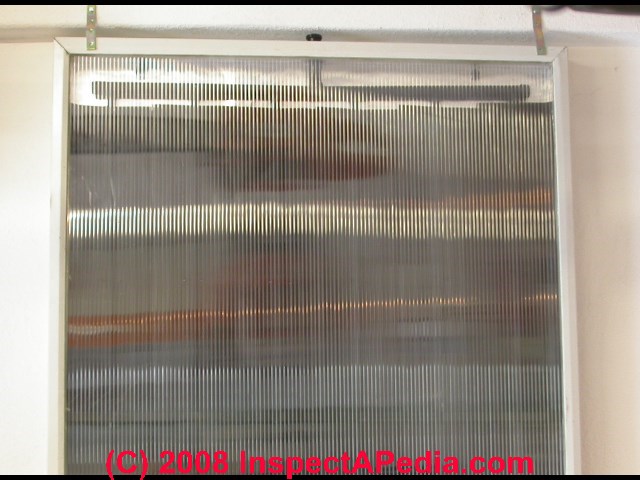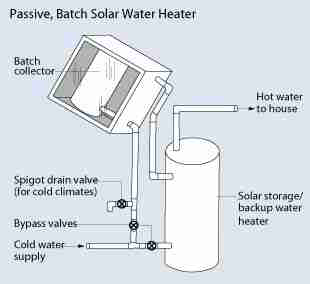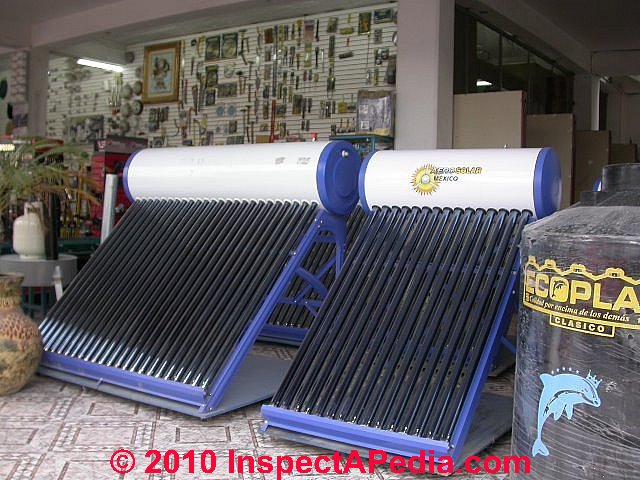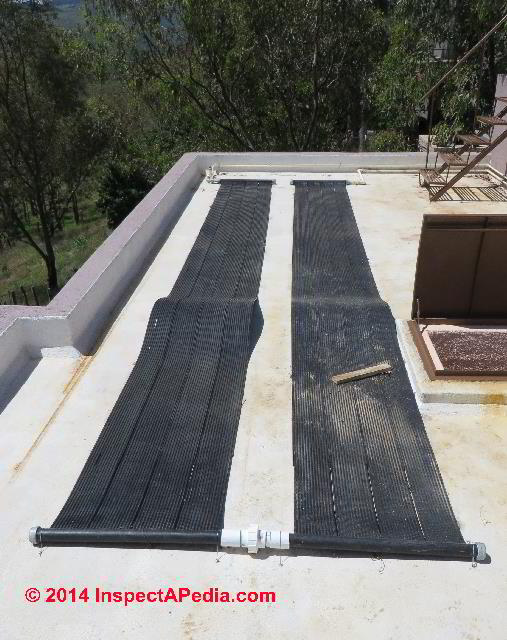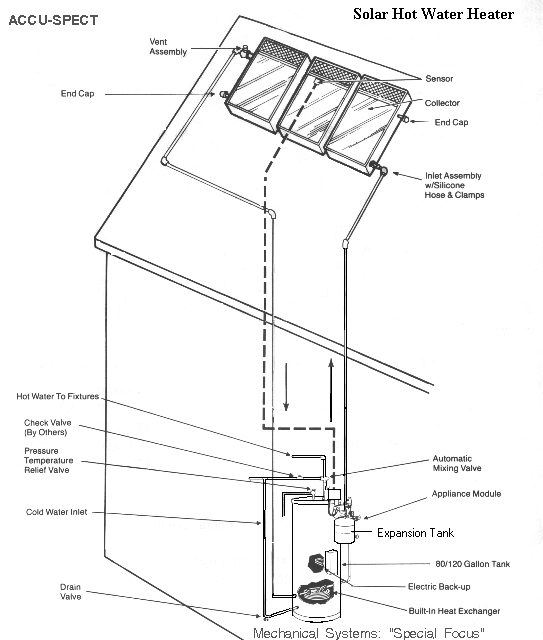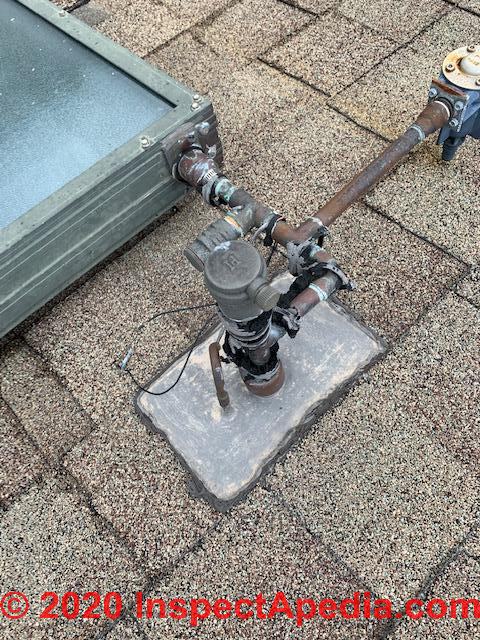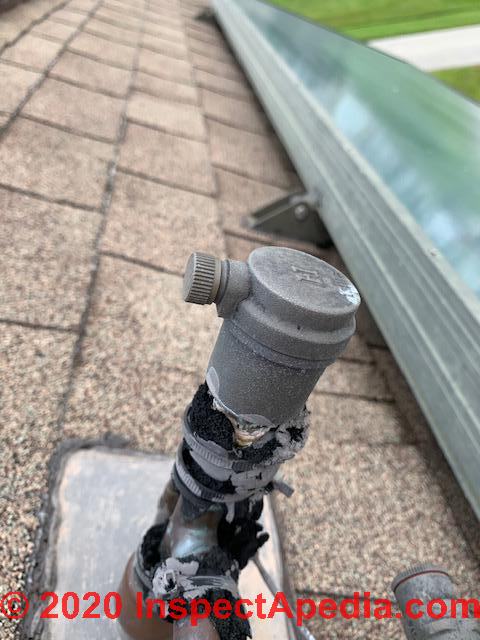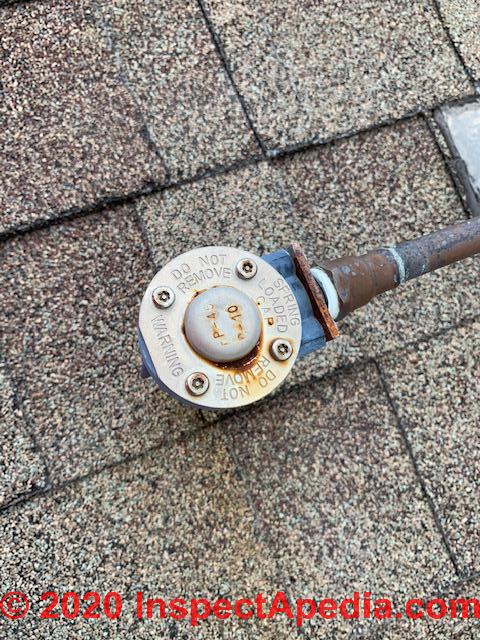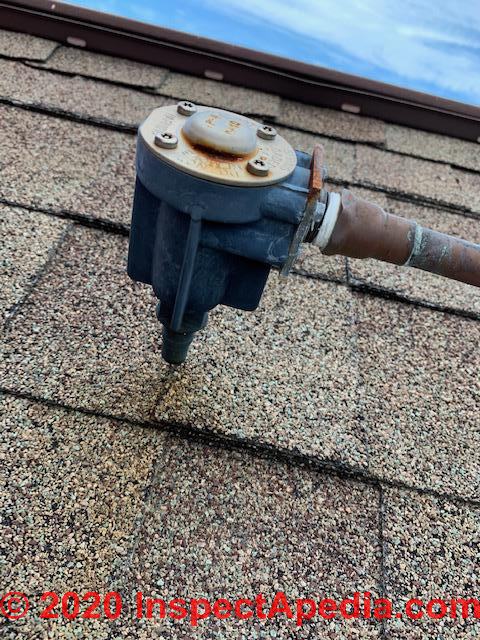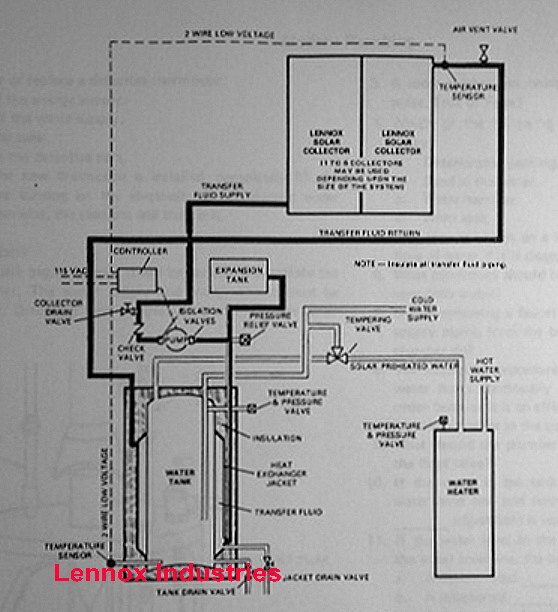 Guide to the Basics of Solar Hot Water Heating Systems
Guide to the Basics of Solar Hot Water Heating Systems
- POST a QUESTION or COMMENT about solar water heater systems: choices, properties, installation, maintenance & repair
Solar water heaters: this article explains the basic components of solar hot water heating systems used to heat water for washing and bathing.
Solar water heaters use renewable energy - sunlight - collected in outdoor rooftop or ground-mounted solar collectors to heat water which is circulated by a pump between a hot water storage tank and the panels.
InspectAPedia tolerates no conflicts of interest. We have no relationship with advertisers, products, or services discussed at this website.
- Daniel Friedman, Publisher/Editor/Author - See WHO ARE WE?
How to Hook Up & Use Solar Water Heating Systems to Provide Domestic Hot Water
Sketch of the hookup schematic for solar hot water heating shown at page top was provided courtesy of Lennox Industries.
Solar water heaters use renewable energy - sunlight - collected in outdoor rooftop or ground-mounted solar collectors to heat water which is circulated by a pump between a hot water storage tank and the panels.
The upper end of a simple solar water heater collector is shown in our photo at left. Look closely and behind the corrugated plastic surface, at the top you can see the horizontal black tubing that moves water through the top end of this collector.
Solar water heaters have been in use for decades, with popular use at remote cottages or off-the-grid buildings and are likely to see increasing use in much of the world as energy costs continue to climb.
What are the Components of a Solar Hot Water Heating System?
 ...
...
The schematic above (U.S. Department of Energy) explains a typical active, closed loop solar water heater hookup and shows the basic parts of a solar hot water system.
The schematic below (U.S. DOE) explains a typical passive-batch solar water heating system, showing the batch collector containing a volume of hot water and located separately from a backup solar water storage or water heater tank.
[Click to enlarge any image]
Here are the key parts of solar hot water heating systems:
Our solar water heater photographs below show a convection-type solar water heater widely distributed in Mexico. The white water tank and the bank of solar heating tubes are initially filled with cold water.
As the sun heats water in the parallel heater tubes, warmed water rises by convection in the tubes and enters the storage tank while cooler water from the tank falls into the tubes for further heating.
Heated water is drawn from a fitting at tank top while incoming cool water is fed into the tank bottom.
This system heats water and stores it in the reservoir tank using only natural convection with no pump required. Our second photo (below right) shows one of these systems installed.

- One or more solar collectors are located where they will receive an appropriate (or maximum) amount of sunlight. In our photo below you can see a simple solar collector hanging at the Don Pedro Ferreteria hardware store in San Miguel de Allende, Mexico.
- Heat exchanger
The solar hot water collectors are connected by a loop of piping to a heat exchanger unit located inside of a hot water storage tank located in the building.
In other words, the building's domestic water supply to be heated is not itself circulated through the solar collector but rather it is heated inside the water tank by a heat exchanger which itself contains a liquid (containing an anti-freeze in northern climates) which circulates in the solar collectors and inside the heat exchanger.
Our photo (left) illustrates a rooftop heat exchanger: a rubber tubing solar collector system on a rooftop in Guanajuato, Mexico. This solar water heating system producers domestic hot water for washing & bathing and for a hot tub.
The solar gain on this rooftop was so high that the owners have blocked some of the tubing to prevent excessive hot water temperatures.
In the FAQs found at the end of this article we include additional photographs of this installation.
- A hot water storage tank
contains domestic hot water heated by the heat exchanger; the tank is supplied with incoming cold water and provides outgoing hot water to the building's plumbing fixtures.
In our photo below you can see a simple solar water heater tank at the Don Pedro Ferreteria hardware store in San Miguel de Allende, Mexico.
In areas where there is plenty of sunlight and water usage is more modest, a simple collector, pump, controls, and small water tank such as the one we show below are often adequate.
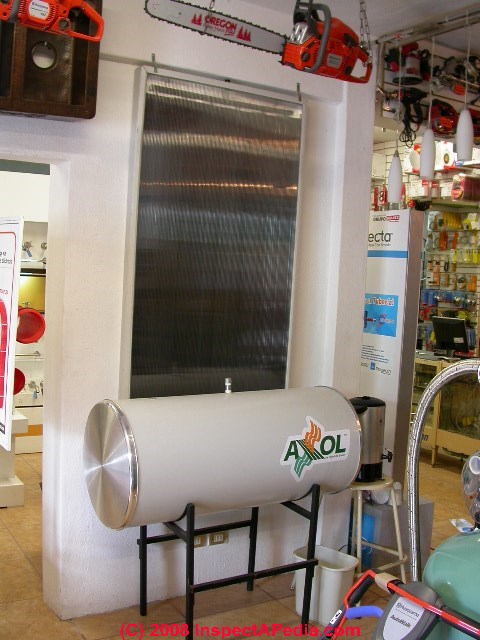
- Temperature sensors
mounted at the water storage tank and also at the solar collectors monitor water temperatures and communicate with a solar controller module. - The solar controller module
determines when it is appropriate to circulate water from the hot water tank through the solar collectors, preventing water circulation when it would cool rather than warm the hot water. - A circulator pump
is controlled by the solar controller module to move water between the solar collectors and the hot water storage tank
. See HEATING SYSTEM CIRCULATOR PUMPS & CIRCULATOR RELAYS for details. - An expansion tank
absorbs the pressure increase created in the (closed) system when water is heated.
See HEATING BOILER EXPANSION TANKS for details. - A pressure and temperature relief valve
is provided on the hot water tank for safety - An air vent valve
is provided at the solar collectors to avoid the piping becoming air bound, purging un-wanted air in the water circulation loop. - A tempering valve or mixing valve
is installed to mix cold water in with the outgoing hot water from the hot water tank, permitting storage of more heat in the water tank without risking scalding building occupants. We discuss tempering valves or mixing valves in detail
at MIXING & ANTI-SCALD VALVES - A backup hot water heater
is usually provided, using electricity, gas, oil, or other fuel to assure that there is adequate hot water when weather conditions do not provide enough solar energy.
As energy costs continue to increase the payback-time for the cost of solar panels and piping installation for solar hot water systems will continue to improve. The solar water heater system sketch is courtesy of Accu-Spect.
Especially in areas that receive adequate sunlight we should expect to see an increase in popularity of these systems.
Solar Hot Water System Resources
- ABSORPTION HEAT PUMPS & COOLERS [PDF] U.S. DOE
- ACTIVE SOLAR HEATING SYSTEMS [PDF] U.S. Department of Energy, including
- HEAT EXCHANGERS FOR SOLAR WATER HEATING SYSTEMS [PDF] U.S. DOE describes the types of solar water heater heat exchange methods between the sun and the building's hot water supply
- HEAT-TRANSFER FLUIDS FOR SOLAR WATER HEATING SYSTEMS [PDF] U.S. DOE, describes the types of fluids selected to transfer heat between the solar collector and the hot water in storage tanks in a building. These include air, water, water with glycol antifreeze mixtures (needed when using solar hot water systems in freezing climates), hydrocarbon oils, and refrigerants or silicones for heat transfer.
- SIDE BY SIDE TESTING of EIGHT SOLAR WATER HEATING SYSTEMS [PDF] ETSU S/P3/00275/REP/2, DTI Pub URN 01/1292, Contractor, The Energy Monitoring Company Ltd., C Martin, M Watson, 2001
This study compared the amount of energy that eight modern solar water heating systems could produce over an average year. - original is at http://www.berr.gov.uk/files/file16826.pdf - Steibel SOLAR HOT WATER COLLECTOR INSTALLATION MANUAL [PDF] solar hot water heating systems, https://www.stiebel-eltron-usa.com/products/solar-thermal-hot-water-systems-individual-components retrieved 2020/04/27, original source: https://www.stiebel-eltron-usa.com/sites/default/files/pdf/install-sol27.pdf
Excerpt: Warning: setting the maximum tank temperature higher than 140 °F at the control unit is permissable only with a thermostatically-conrolled DHW mixing valve. Otherwise there can be a risk of scalding at the drawoff point. - Desmex Solar, Blvd. José Ma. Morelos 3649, Col. Purísima de Jerez, León, Gto. C.P.37290
Tel. +52 (477) 788 06 00, Fax. +52 (477) 771 10 02, e-mail: leon@desmexsolar.com: website http://www.desmexsolar.com/ Additional offices in
San Miguel de Allende, Guanajuato, Mexico - Carretera a Celaya Km. 1, Plaza Alhóndiga Local 14 (1M), Frente a Mega Comercial Mexicana, San Miguel de Allende, Gto. Tel: +52 (415) 150 73 12 e-mail: sanmiguel@desmexsolar.com,
Guadalajara, Mexico - +52 (33) 3165-2454 e-mail: guadalajara@desmexsolar.com, Monterrey Mexico - Tel. +52 (818) 356 43 30 e-mail: monterrey@desmexsolar.com, and Mexico City - Tel. +52 (55) 2643 26 29, Fax. +52 (477) 771 10 02 e-mail: mexico@desmexsolar.com - PASSIVE SOLAR HANDBOOK VOL. I [PDF] the Passive Solar Handbook Introduction to Passive Solar Concepts, in a version used by the U.S. Air Force
- PASSIVE SOALR HANDBOOK VOL. II [PDF] the Passive Solar Handbook Comprehensive Planning Guide, in a version used by the U.S. Air Force - online version available at this link and from the USAF also at wbdg.org/ccb/AF/AFH/pshbk_v2.pdf [This is a large PDF file that can take a while to load]
- PASSIVE SOLAR HANDBOOK VOL. III [PDF] the Passive Solar Handbook Programming Guide, in a version used by the U.S. Air Force - online version available at this link and from the USAF also at wbdg.org/ccb/AF/AFH/pshbk_v3.pdf
- The Passive Solar Design and Construction Handbook, Steven Winter Associates (Author), Michael J. Crosbie (Editor), Wiley & Sons, ISBN 978-047118382 or 0471183083
- PASSIVE SOLAR HOME DESIGN [PDF] [PDF] U.S. Department of Energy, describes using a home's windows, walls, and floors to collect and store solar energy for winter heating and also rejecting solar heat in warm weather.
- Solar Water Heating: A Comprehensive Guide to Solar Water and Space Heating Systems (Mother Earth News Wiser Living Series), Bob Ramlow, Benjamin Nusz, ISBN13: 9780865715615
Heating water with the sun is almost as old as humankind itself, and it is done all over the world. Yet there are strangely few resources on the topic in North America.
Solar Water Heating fills this gap. It reviews the history of solar water and space heating systems from prehistory to the present, then presents the basics of solar water heating, including an introduction to modern solar energy systems, energy conservation and energy economics. Drawing on the author’s experience as an installer of these systems, the book goes on to cover:
* Types of solar collectors, solar water and space heating systems and solar pool heating systems, including their advantages and disadvantages * System components, their installation, operation, and maintenance * System sizing and siting * Choosing the appropriate system.
Since people often get turned off by the up-front cost, the book focuses especially on the financial aspects of solar water or space heating systems, clearly showing that such systems can save significant costs in the long run. Well-illustrated, the book is designed for a wide readership from the curious to the student or professional. - RADIANT HEATING SYSTEMS [PDF] U.S. DOE
- SOLAR AIR HEATING [PDF] U.S. DOE also referred to as "Ventilation Preheating" in which solar systems use air for absorbing and transferring solar energy or heat to a building
- SOLAR LIQUID HEATING [PDF] U.S. DOE, systems using liquid (typically water) in flat plate solar collectors to collect solar energy in the form of heat for transfer into a building for space heating or hot water heating. The term "solar liquid" is used for accuracy, rather than "solar water" because the water may contain an antifreeze or other chemicals.
- SOLAR WATER HEATERS [PDF] U.S. Department of Energy article on solar domestic water heaters to generate domestic hot water in buildings, explains how solar water heaters work. Solar heat for swimming pools is also discussed.
- SOLAR WATER HEATING SYSTEM MAINTENANCE AND REPAIR [PDF] U.S. DOE
- SOLAR WATER HEATING SYSTEM FREEZE PROTECTION [PDF] U.S. DOE,using antifreeze mixture in solar water heaters (or other freeze-resistant heat transfer fluids), as well as piping to permit draining the solar collector and piping system.
- SCALING AND CORROSION IN SOLAR WATER HEATING SYSTEMS [PDF] U.S. DOE - www.energysavers.gov/your_home/water_heating/index.cfm/mytopic=12850 is the base U.S. DOE website for these articles
- Also see REFERENCES below
...
Reader Comments, Questions & Answers About The Article Above
Below you will find questions and answers previously posted on this page at its page bottom reader comment box.
Reader Q&A - also see RECOMMENDED ARTICLES & FAQs
On 2021-10-12 by Gregory Jones - troubleshoot loss of all hot water from a Solahart water heater, Canberra Australia
 @inspectapedia.com.moderator, Thank you very much for this information. Somewhere to start.
@inspectapedia.com.moderator, Thank you very much for this information. Somewhere to start.
We have a solar hot water tank on the roof. We started having flow problems with the hot water about a month ago. (All taps are hot/cold mixers and the cold flow is fine.)
In the morning the hot water flow and pressure is fine. Also at lunch time and again when showering in the afternoon although sometimes the shower hot water pulses for 30 seconds until we get a steady flow.
This is a recent development. However, in the evening the hot water flow to all taps often ceases altogether.
Sometimes if the hot tap is left open the flow returns after a few minutes but normally we have to wait until a few hours later for it to return.
Could there be a valve/washer somewhere that heats up and expands and stops the hot water flow? (My very amateur diagnosis!) The solar tank manufacturer was quite sure (of course) that it was not a fault with the tank.
Any advice. Thank you.
This Q&A were posted originally
Reply by inspectapedia.com.moderator (mod)
@Gregory Jones,
Of course the manufacturer says it's not their fault; but ducking and weaving aside, it' s too bad that the manufacturer of y our solar water heater didn't have someone who could offer even the slightest suggestion.Usually the manufacturer, if they've been in business for a year or longer, has one or more engineers who have already worked with their customers who have run into just about every snafu imaginable, and some unimaginable ones.
Tell us a bit more about your solar hot water system: brand, model, country and city of installation, system age, and maybe post a schematic or sketch.
I've seen pulsing water traced to a small electric water pump that was pumping against a partly-closed valve or against an obstruction.
But surely the total cessation of hot water flow in the evening is diagnostic.
What's different besides daylight and temperature change?
Are there any timers on the system?On 2021-10-11 by Gregory Jones
@inspectapedia.com.moderator, Thank you for your response. The hot water system is Solar Hart. It was installed circa 2003 in Canberra, Australia. I have included a photo and (if I can add two + photos) a photo of the plumbing connections - temperate valve and the valve which controls the amount of cold diluting the hot flow.
Greg Jones
(I'll send second as separate comment)On 2021-10-11 by inspectapedia.com.moderator (mod)
@Gregory Jones,
Have you stepped through all of the valves and controls for this solar water heater to be sure that none of them is closing unexpectedly?Examples of controls that may affect water flow from your Solahart solar water heater
- Does your unit use a thermosiphon restrictor valve? Is that valve sticking? Have you tried replacing it. [ 344391 (TRV) ]
- Your unit uses a temperature limit device that will shut off flow through the collectors if temperatures are too high; I agree that temperatures drop, rather than rise, at night, even in Australia, but I'm not sure what a bad control might to.
- Does your unit use an in-series continuous flow gas booster to protect against Legionella?
- Is there a flow control associated with the manufacturer's recommended electrical temperature booster?
- Is there a temperature control bypass valve
- When you have no hot water at a tap, if you go to the solar water heaters temperture-pressure relief valve and open the test lever does water flow?
- Have you checked your system's pre-charge pressure against the IO manual's instructions and matched it to the pressure-relief (PR) valve specs ?
If you don't already have it, you can download the
- SOLAHART WATER HEATERS INSTALLATION & OPERATION MANUAL [PDF] (2016) Solahart Industries Pty Ltd
(ABN 45 064 945 848) PO Box 7508, Rydalmere NSW 2128, Australia Web: https://www.solahart.com.au/ - original source: https://www.solahart.com.au/media/3409/33-1197_j-solahart-thermosiphon-owners-manual-2016-january.pdf
Or give the company a call
Australia
For SERVICE Telephone - 1800 638 011
or your nearest Solahart Dealer
For Sales Telephone - 1300 769 475Readers interested in a backup electrical power may also want to see this
- SOLAHOT PV SYSTEM HOT WATER HEATER OWNERS MANUAL [PDF] (2017)
Excerpt: (This is an electrical generator system NOT a water heater)
The photovoltaic (PV) modules transform solar radiation into electrical energy in the form of direct current (DC). In order to utilise this energy and feed it back into the grid, the direct current is transformed into alternating current (AC) by the inverter.
This conversion is also known as DC to AC inversion. The alternating current generated by the inverter is fed into the main switchboard, which in turn is connected to the grid.
How do we identify the type of solar panel and how do we operate / maintain it?
We purchased a home with solar water heat panel. How do we identify the type of panel and how do we operate / maintain it?
The electric hot water heater has four pipes in/out (two of which go up, assumed to the panel) There are also two circulator pumps, one of which is wired to some control box. I believe the second recirculator is for bringing fast hot water to the far end of the house.
Thank you, cheers... On 2020-05-17 by KurtS Curtis
On 2020-05-17 - by (mod) -
Good question, Kurt.
Look at all of the components you can safely access - without falling off a ladder or roof.
Post photos (one per comment) of the controls, equipment, and in particular any labels or markings, even simple patent numbers, and I can research the maker and probably find the operating instructions for you. r.
On 2020-05-18 by KurtS Curtis - Photos of my Solar system controls, valves, panels - for identification
Thank you, this is great!
1st is an overall pic of the entire assembly of valves. This was taken yesterday before i saw this reply, so I only have what I have for the moment.
This picture is the upper RH corner and I believe it is some pressure relief safety valve/vent, a thermo sensor (pulled from the mounting by a bird looking for nesting material) and then two other type valves that I can imagine opening to bleed air from the system or draining vent perhaps.
The lower left corner of the panel appears to simply be a pipe penetrating the roof (not going to have a picture of that)
Here are photos of my solar system components.
Another valve type fitting (not able to turn by hand)
Foreground (lower center) is a 1/4 copper tube that the thermo sensor appeared to have been pulled from. I half pushed it back into the silicone 'potting'.
The sweat copper tee pictured (lower left) behind this valve goes out about ten inches to what I think is a pressure relief valve picture in first post.
Fourth is the highest point in the system and sits atop a TEE fitting above the pipe that penetrates the roof. (I aSSuME it is a bleed screw of sorts) I couldn't resist and opened it momentarily, nothing exhausted nor did I sense that I broke a vacuum and allowed air to enter...
When I was a kid, the folks called me "Knobs" as I was always trying something.Third, top view of marking of (valve, pressure safety)
This second pix of the perhaps (pressure safety valve) with evidence of prior venting...
Reply by (mod) - identify the controls on an older rooftop solar hot water panel system
I have to say those solar panel controls and fragments I can see of the actual solar panels look more than 20 years old.
Inside are there storage tanks, pumps, controls, with labels or names on them?
Somewhere there must at least be a solar control module similar to this Pentair example I'll post below
Your photos show in reverse order below:
A pressure/temperature relief valve - an important safety device
An automatic air bleeder valve (keep that cap loose) intended to prevent the solar system from becoming air-bound
An over-fill vent or over-pressure vent
A collection of these controls at the corner of a rooftop solar panel
Connect a solar heating system on a pressurised water system?
Can I connect a solar heating system on a pressurised water system in my house? - On 2018-01-21 by Charles Manyara -
Reply by (mod) -
Sure Charles. Look at the page top sechematic as an example.
Question: which is most efficient backup system for solar hot water?
The solar system I am pricing has one backup heating element, in the middle of the tank. I expect a lot of my use will be at night, therefore I was an efficient electrical system too.
Would the performance of a supply tank with an element on the top and on the bottom, at traditional tank, be more efficient and supply more hot water than the single element, middle mounted heating element? - dan@dudden.com
Reply:
Interesting question Dan. I don't know - insofar as being able to cite an authoritative source without more research. But it may help to understand the role of dual heating elements in electric water heaters.
The lower element warms all water in the tank, starting with cold water entering (cold water usually is directed to the tank bottom by a dip tube). The upper element boosts the ending temperature of hot water leaving the tank.
We should both read some detailed descriptions of the operating of dual-element electric water heaters. My experience with models I've tested and repaired was that both elements worked simultaneously.
If we find a single-element electric water heater tank I figure it's probably because it's a pretty small tank.
You may be better served by choosing the tank size closely matched to your needs so as not to heat more hot water than needed, using a timer to turn off the electric heaters when not wanted or needed, and choosing a water heater with a high energy rating.
Question: Thermal slab with pipes deep in the concrete?
Current building regs here in Scotland dictate that I fit a thermal slab of at least 125mm thick as a floor in my house extension. I couldn't see the point of just relying on the sun through the window to heat it so I fitted under floor heating pipes.
The slab is 250 mm thick,the pipes are 200mm below the surface,there is 170mm of "kingspan " between the membrane/subsoil and the edges are insulated with 5mm Kingspan.
I intend to fit a solar hot water panel to slowly,maybe over several days ,heat the slab,intending it to be a heatstore rather than a radiator ,say from a boiler system.
I can see from many posts on this site that my pipes are in too deep for a radiant system ,heated from a boiler,but I think that as a heated from below heat store it should provide a very stable source of heat to keep the room warm through the night or dull days( plenty of those in Scotland)
Comments please.Reply:
Lee, my experience is that pipes deep in the slab don't work well - which is reflected in the documents by experts in the radiant heating indusry. There are two heat transmission issues:
1. heat loss downwards into soil that exceeds the heat flow upwards into occupied space - you MIGHT overcome this by very good insulation between the slab underside and the soil, resulting in a huge heat sink that takes a long time to heat but eventually sends heat upwards; (If this works in your case do let us know.)
2. heat transfer resistance in the upwards direction caused by the thickness of concrete.
In sum, I'm not optimistic. Can you tell me the R-value of 170mm of Kingspan insulation? Also have you insulated the slab perimeter?For technical details about placing heating tubing of any sort in to concrete slabs, see these articles:
Passive solar heated slabs: SLAB INSULATION, RADIANT / PASSIVE SOLAR
Watch out: be sure to read RADIANT HEAT FLOOR MISTAKES
Reader follow-up:
The R value is 5.100 M2.k/w.Yes the edges have 50mm of the same spec kingspan.The floor slab is encosed in the foundation wall and above ground level.
Nothing much lost if it doesn't work,just the £70 for the barrier pipe.I will just have to fit a conventional radiator to the wall and connect the panel to the hot water tank if the heat goes down into the subsoil. Do you think that heat would rise through a solid ,as it does through a gas or liquid?
My aim is to help the thermal store by feeding heat in from below, I want the process to be slow( no avoiding that with the pipes in deep eh.)
On reflection maybe midway up would have been better,but after the initial outlay for the panels , the heat is almost free,might just need a few more. Thanks for you comment, will let you know if it works,probably won't be operational for 18 months or so.
Reply:
Lee,
We'd need to discuss details of some of your questions with a heat transfer engineer; but in general, various solids conduct heat at varying rates, and solids won't have internal currents or movements that occur in liquids or gases. Heat transmits through a solid mor or less at the same rate in all directions, with variation of course when one side of a solid is in contact with or exposed to conditions or temperatures different from another side.
In my OPINION, heat transfers down through an uninsulated concrete slab into the (normally cooler) earth at a rate faster than heat will transfer up through an uninsulated concrete slab into air (normally warmer) in a building above.
In the RADIANT HEAT Floor Mistakes to Avoid article cited above, we had to abandone the in-slab radiant heat floor system.Trials confirmed that it was simply impossible to get the building warm - the rate of heat movement into the earth below the slab (not uniformly insulated, not enough insulation, and tubing too deep in the slab) always exceeded heat movement into the building.
We kept the tiny boiler that had been installed to heat this building and considered installing a thin-set radiant heat tubing floor under a new layer of tile atop the original installation.But because we (and the otherwise goofy builder) had done a good job on building insulation of the walls and roof we found that we could heat the building ( a small cabin) with just a couple of electric heaters + some solar gain thorugh windows and skylights) in cold though perhaps not the coldest (northern Minnesota) temperatures.
Your floor will store passive solar gain heat from sun exposure but I suspect the tubing system will operate at a net loss.
Question: is it normal for the solar hot water panels to be empty or to collapse?
Are solar mats supposed to collapse when [the solar heating system] is turned off?
And is [the solar hot water heating system] meant to be and open air system or a closed system? - L.S. 1/22/2014
Reply:
You are asking about solar hot water or solar heating systems that use a water-antifreeze mix.
Among the many types of solar collectors are rubber tubes bonded in mats or gangs of tubing fed at either end by a connected rigid tube connected to the inlet and outlet piping for the system.
Depending on the manufacturer, these tub-mats are rather rigid and would look the same with or without water flowing, while others, made of softer plastic or rubber components may thin down when not under water pressure. In both cases the system stays full of water, not air, when the system is activated.
The solar hot water panel ends shown in my photographs just above are installed on a rooftop in Guanajuato, Mexico and are used to provide domestic hot water and to heat a spa or hot tub. This is a rigid mat, it does not "collapse" when water is not circulating
. In fact there is so much solar gain on this roof that the owners have blocked off some of the solar collector tubing so that water is not overheated. Not shown in my photos is a pressure relief safety valve installed on the piping to release water in the event of an unsafe or over-pressure condition.
You can see the solar water heater piping, a control valve, and the pressure-relief safety valve in this photo.
But in freezing climates and for some heating applications that are heating water for direct use, that is where an antifreeze mix is not being used in the solar heating system, the system is designed to drain-down when off in freezing weather, to prevent freeze-up.
A drain-down solar design will indeed be virtually empty of water in that state: additional controls and air valves are installed on such systems to allow air in or to allow air to exit as required to prevent freezing.
I hope that with these details, if your question is not answered fully you can ask again with more information.
...
Continue reading at SOLAR WATER HEATER ANTIQUE or select a topic from the closely-related articles below, or see the complete ARTICLE INDEX.
Or see these
Recommended Articles
- HOT WATER IMPROVEMENTS
- HOT WATER PRESSURE IMPROVEMENT
- HOT WATER QUANTITY IMPROVEMENT
- IDENTIFY WATER TANK USE
- SOLAR ENERGY SYSTEMS - home
- SOLAR HEATING SYSTEM DESIGNS
- SOLAR HOT WATER HEATER TEMPERATURE CONTROL
- SOLAR HOT WATER HEATERS
- WATER HEATER PROBLEM DIAGNOSIS
- WATER HEATER COMPARISONS, PROPERTIES
- WATER HEATER TEMPERATURE ADJUSTMENT CONTROLS
Suggested citation for this web page
SOLAR HOT WATER HEATERS at InspectApedia.com - online encyclopedia of building & environmental inspection, testing, diagnosis, repair, & problem prevention advice.
Or see this
INDEX to RELATED ARTICLES: ARTICLE INDEX to SOLAR ENERGY
Or use the SEARCH BOX found below to Ask a Question or Search InspectApedia
Ask a Question or Search InspectApedia
Try the search box just below, or if you prefer, post a question or comment in the Comments box below and we will respond promptly.
Search the InspectApedia website
Note: appearance of your Comment below may be delayed: if your comment contains an image, photograph, web link, or text that looks to the software as if it might be a web link, your posting will appear after it has been approved by a moderator. Apologies for the delay.
Only one image can be added per comment but you can post as many comments, and therefore images, as you like.
You will not receive a notification when a response to your question has been posted.
Please bookmark this page to make it easy for you to check back for our response.
IF above you see "Comment Form is loading comments..." then COMMENT BOX - countable.ca / bawkbox.com IS NOT WORKING.
In any case you are welcome to send an email directly to us at InspectApedia.com at editor@inspectApedia.com
We'll reply to you directly. Please help us help you by noting, in your email, the URL of the InspectApedia page where you wanted to comment.
Citations & References
In addition to any citations in the article above, a full list is available on request.
- Mark Cramer Inspection Services Mark Cramer, Tampa Florida, Mr. Cramer is a past president of ASHI, the American Society of Home Inspectors and is a Florida home inspector and home inspection educator. Mr. Cramer serves on the ASHI Home Inspection Standards. Contact Mark Cramer at: 727-595-4211 mark@BestTampaInspector.com
- In addition to citations & references found in this article, see the research citations given at the end of the related articles found at our suggested
CONTINUE READING or RECOMMENDED ARTICLES.
- Carson, Dunlop & Associates Ltd., 120 Carlton Street Suite 407, Toronto ON M5A 4K2. Tel: (416) 964-9415 1-800-268-7070 Email: info@carsondunlop.com. Alan Carson is a past president of ASHI, the American Society of Home Inspectors.
Thanks to Alan Carson and Bob Dunlop, for permission for InspectAPedia to use text excerpts from The HOME REFERENCE BOOK - the Encyclopedia of Homes and to use illustrations from The ILLUSTRATED HOME .
Carson Dunlop Associates provides extensive home inspection education and report writing material. In gratitude we provide links to tsome Carson Dunlop Associates products and services.


